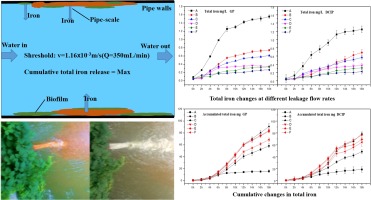当前位置:
X-MOL 学术
›
Water Res.
›
论文详情
Our official English website, www.x-mol.net, welcomes your
feedback! (Note: you will need to create a separate account there.)
Change regularity of water quality parameters in leakage flow conditions and their relationship with iron release
Water Research ( IF 11.4 ) Pub Date : 2017-07-16 00:00:00 , DOI: 10.1016/j.watres.2017.07.027 Jingqing Liu , Huabin Shentu , Huanyu Chen , Ping Ye , Bing Xu , Yifu Zhang , Hamid Bastani , Hongxi Peng , Lei Chen , Tuqiao Zhang
Water Research ( IF 11.4 ) Pub Date : 2017-07-16 00:00:00 , DOI: 10.1016/j.watres.2017.07.027 Jingqing Liu , Huabin Shentu , Huanyu Chen , Ping Ye , Bing Xu , Yifu Zhang , Hamid Bastani , Hongxi Peng , Lei Chen , Tuqiao Zhang

|
The long-term stagnation in metal water supply pipes, usually caused by intermittent consumption patterns, will cause significant iron release and water quality deterioration, especially at the terminus of pipelines. Another common phenomenon at the terminus of pipelines is leakage, which is considered helpful by allowing seepage of low-quality drinking water resulting from long-term stagnation. In this study, the effect of laminar flow on alleviating water quality deterioration under different leakage conditions was investigated, and the potential thresholds of the flow rate, which can affect the iron release process, were discussed. Based on a galvanized pipe and ductile cast iron pipe pilot platform, which was established at the terminus of pipelines, this research was carried out by setting a series of leakage rate gradients to analyze the influence of different leakage flow rates on iron release, as well as the relationship with chemical and biological parameters. The results showed that the water quality parameters were obviously influenced by the change in flow velocity. Water quality was gradually improved with an increase in flow velocity, but its change regularity reflected a diversity under different flow rates (p<0.05). The iron release was remarkably correlated to the redox potential, dissolved oxygen, pH, iron-oxidized bacteria and sulfate-reducing bacteria. The cumulative total iron release (r=0.587, p<0.05) and total iron release rate (r=0.71, p<0.022) were significantly influenced by the changes in flow velocity. In short, they tended first to increase and then to decrease with an increasing flow velocity with the threshold as approximately 40% of the critical laminar flow velocity (1.16×10-3 m/s). For the pipes at the terminus of the drinking water distribution system, when the bulk water was at the critical laminar flow velocity, the concentration of total iron, the quantity and rate of total iron release remain relatively in an ideal and safe situation.
中文翻译:

渗流条件下水质参数的变化规律及其与铁释放的关系
金属供水管道的长期停滞通常是由间歇性的消耗模式引起的,这将导致铁的大量释放和水质的恶化,尤其是在管道末端。管道末端的另一个常见现象是泄漏,这被认为有助于防止长期停滞导致的劣质饮用水的渗入。在这项研究中,研究了层流对缓解不同泄漏条件下水质恶化的影响,并讨论了可能影响铁释放过程的流速的潜在阈值。基于在管道末端建立的镀锌管道和球墨铸铁管道试验平台,通过设置一系列泄漏率梯度来进行这项研究,以分析不同泄漏率对铁释放的影响以及与化学和生物学参数的关系。结果表明,流速变化明显影响水质参数。水质随着流速的增加而逐渐改善,但其变化规律反映了不同流速下的多样性(p<0.05)。铁的释放与氧化还原电势,溶解氧,pH,铁氧化细菌和硫酸盐还原细菌显着相关。流速的变化对累积的总铁释放量(r = 0.587 ,p < 0.05)和总铁释放速率(r = 0.71 ,p < 0.022)有显着影响。简而言之,它们倾向于随着流速的增加先增大然后减小,其阈值大约为临界层流速度的40%(1.16×10 -3多发性硬化症)。对于饮用水分配系统末端的管道,当散装水处于临界层流速度时,总铁的浓度,总铁释放的量和速率在理想和安全的情况下相对保持不变。
更新日期:2017-07-17
中文翻译:

渗流条件下水质参数的变化规律及其与铁释放的关系
金属供水管道的长期停滞通常是由间歇性的消耗模式引起的,这将导致铁的大量释放和水质的恶化,尤其是在管道末端。管道末端的另一个常见现象是泄漏,这被认为有助于防止长期停滞导致的劣质饮用水的渗入。在这项研究中,研究了层流对缓解不同泄漏条件下水质恶化的影响,并讨论了可能影响铁释放过程的流速的潜在阈值。基于在管道末端建立的镀锌管道和球墨铸铁管道试验平台,通过设置一系列泄漏率梯度来进行这项研究,以分析不同泄漏率对铁释放的影响以及与化学和生物学参数的关系。结果表明,流速变化明显影响水质参数。水质随着流速的增加而逐渐改善,但其变化规律反映了不同流速下的多样性(p<0.05)。铁的释放与氧化还原电势,溶解氧,pH,铁氧化细菌和硫酸盐还原细菌显着相关。流速的变化对累积的总铁释放量(r = 0.587 ,p < 0.05)和总铁释放速率(r = 0.71 ,p < 0.022)有显着影响。简而言之,它们倾向于随着流速的增加先增大然后减小,其阈值大约为临界层流速度的40%(1.16×10 -3多发性硬化症)。对于饮用水分配系统末端的管道,当散装水处于临界层流速度时,总铁的浓度,总铁释放的量和速率在理想和安全的情况下相对保持不变。















































 京公网安备 11010802027423号
京公网安备 11010802027423号